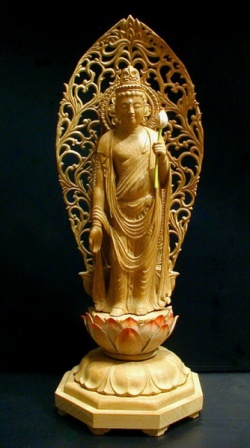Difference between revisions of "Kao-ch'ang"
(Created page with "thumb|250px| <poem> Kao-ch'ang [高昌国] (PY Gaochang; Jpn Kosho-koku) An ancient kingdom of the {{Wiki|Turfan}} region of what is no...") |
|||
| (One intermediate revision by the same user not shown) | |||
| Line 2: | Line 2: | ||
<poem> | <poem> | ||
[[Kao-ch'ang]] | [[Kao-ch'ang]] | ||
| − | [高昌国] (PY [[Gaochang]]; Jpn [[Kosho-koku]]) | + | [[高昌国]] (PY [[Gaochang]]; Jpn [[Kosho-koku]]) |
| − | An ancient kingdom of the {{Wiki|Turfan}} region of what is now the eastern part of the {{Wiki|Sinkiang}} {{Wiki|Uighur Autonomous Region}} in northwestern {{Wiki|China}}. The [[Kao-ch'ang]] kingdom, which lasted from the fifth through the seventh century, was situated on the northern side of the {{Wiki|Turfan}} Depression at the foot of the southern slope of the {{Wiki|Tien Shan}} range. [[Buddhism]] prospered there from early on under the reign of the Ch'yclan. In the early seventh century, on the way to {{Wiki|India}}, the Chinese priest [[Hsüan-tsang]] was invited to visit [[Kao-ch'ang]] by the king and ruler of the Ch'yclan, and he was accorded a hospitable welcome. Control by the Ch' | + | An {{Wiki|ancient}} {{Wiki|kingdom}} of the {{Wiki|Turfan}} region of what is now the eastern part of the {{Wiki|Sinkiang}} {{Wiki|Uighur Autonomous Region}} in northwestern {{Wiki|China}}. The [[Kao-ch'ang]] {{Wiki|kingdom}}, which lasted from the fifth through the seventh century, was situated on the northern side of the {{Wiki|Turfan}} [[Depression]] at the foot of the southern slope of the {{Wiki|Tien Shan}} range. [[Buddhism]] prospered there from early on under the reign of the Ch'yclan. In the early seventh century, on the way to {{Wiki|India}}, the {{Wiki|Chinese}} [[priest]] [[Hsüan-tsang]] was invited to visit [[Kao-ch'ang]] by the [[king]] and [[ruler]] of the Ch'yclan, and he was accorded a hospitable welcome. Control by the [[Ch'y clan]] lasted from 498 until 640, when [[T'ang-dynasty]] [[China]] conquered the [[Kao-ch'ang]] {{Wiki|kingdom}}. Today a number of [[Buddhist]] [[temple]] ruins can be found in {{Wiki|Karakhoja}} (also spelled Karakhojo) near the present-day city of {{Wiki|Tur-fan}}. [[Buddhist]] texts written in the {{Wiki|Uighur}} script and {{Wiki|Manichaean}} wall paintings have been excavated there. Many [[caves]] once used as [[Buddhist]] [[temples]] also [[exist]] near {{Wiki|Karakhoja}}. |
</poem> | </poem> | ||
{{R}} | {{R}} | ||
[http://www.sgilibrary.org/search_dict.php?id=1162 www.sgilibrary.org] | [http://www.sgilibrary.org/search_dict.php?id=1162 www.sgilibrary.org] | ||
[[Category:Chinese Buddhist History]] | [[Category:Chinese Buddhist History]] | ||
Latest revision as of 21:25, 16 April 2014
Kao-ch'ang
高昌国 (PY Gaochang; Jpn Kosho-koku)
An ancient kingdom of the Turfan region of what is now the eastern part of the Sinkiang Uighur Autonomous Region in northwestern China. The Kao-ch'ang kingdom, which lasted from the fifth through the seventh century, was situated on the northern side of the Turfan Depression at the foot of the southern slope of the Tien Shan range. Buddhism prospered there from early on under the reign of the Ch'yclan. In the early seventh century, on the way to India, the Chinese priest Hsüan-tsang was invited to visit Kao-ch'ang by the king and ruler of the Ch'yclan, and he was accorded a hospitable welcome. Control by the Ch'y clan lasted from 498 until 640, when T'ang-dynasty China conquered the Kao-ch'ang kingdom. Today a number of Buddhist temple ruins can be found in Karakhoja (also spelled Karakhojo) near the present-day city of Tur-fan. Buddhist texts written in the Uighur script and Manichaean wall paintings have been excavated there. Many caves once used as Buddhist temples also exist near Karakhoja.
